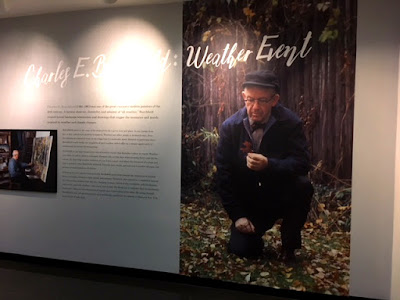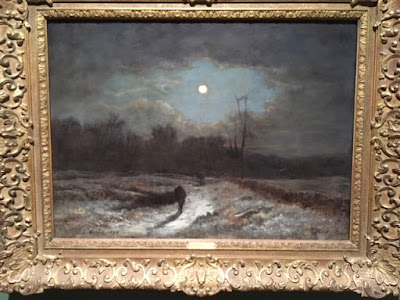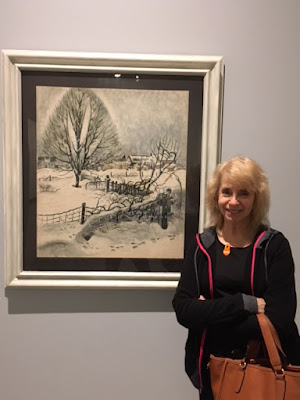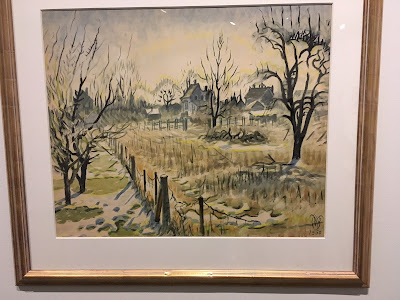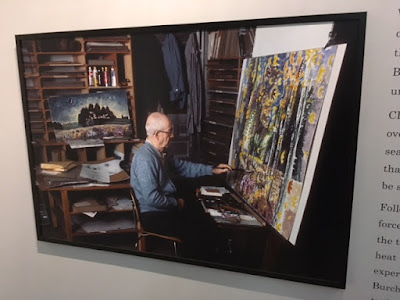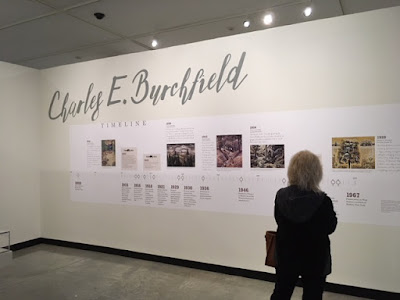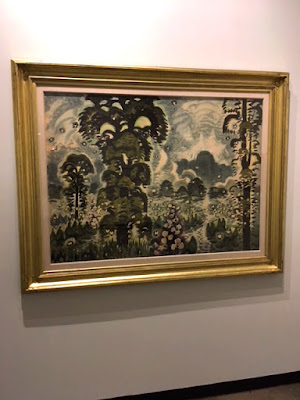An artists job is to notice the important things that others have overlooked. To call them back to see what they've missed.
Busy with the tasks of daily living, we forget all about the drama unfolding in the skies. The painter Charles Burchfield insisted that in the changing weather and the passing of the seasons we find clues to our essential selves.
The current exhibition at the Montclair Art Museum (MAM) in New Jersey is Charles E. Burchfield: Weather Event (through January 7, 2018). The show originates from the Burchfield Penney Art Center in Buffalo, NY. but takes on special meaning in MAM's galleries. The Museum has one of the best collections of George Inness, the visionary late 19th century American landscape artist (Inness lived in Montclair the last 9 years of his life).
George Inness, Winter Moonlight (Christmas Eve), oil
Montclair Art Museum
Inness was renown for his uniquely moody and introspective landscapes. In some ways Burchfield was cut from the same sort of cloth. He created works that grew out of that romantic, visionary tradition. Happily, MAM has hung Weather Event in galleries adjoining their Inness Collection.
MAM also included a Burchfield watercolor from their own collection Day in Midwinter from 1945. Here's my wife Alice admiring it. I think it's a quietly terrific painting.
The scene is one of the ordinary fields in the backyard of Burchfield's Gardenville, NY home, yet in his hands the branches of its tree seem to quiver against a shimmering sky.
Another Burchfield in the exhibition depicts the artist's same backyard on a more sunny winter day. This painting is an old friend to me. For the last two and a half years I've been the Artist in Residence at the Burchfield Penney Art Center (BPAC) in Buffalo, NY. On one of my first stays there I made a detailed copy of it in oil to study the intricate patterns of Burchfield's brushwork.
Charles Burchfield, Early Spring Sunlight, watercolor, 1950.
A large photo in the exhibition of Burchfield working
in his Gardenville, NY studio. Note how Burchfield
had the unusual practice of placing his watercolor
vertically.
A timeline of the artist's life.
Charles Burchfield, Yellow Afterglow, July 31, 1916,
Burchfield Penney Art Center, a view from the
backyard of Burchfield's childhood home in
Salem, OH.
Charles Burchfield, Fireflies and Lightning,
1964-65, a very late watercolor, Burchfield
Penney Art Center.
People accustomed to the huge scale and unorthodox materials common in contemporary art sometimes think of landscape as a tame static art from the past. A close look at Burchfield'sNovember Storm from 1950 (below) reveals just the opposite- a world where grasses, tree trunks and clouds swirl and writhe around each other in an almost violent dance. What a metaphor for the agitated inner state of mind we all experience at times.
Another of my favorites is Clearing Sky, July 1, 1917 (below) with its riotously undulating fields. Burchfield reminds us that the world is an animated place. If we let it it can stir our imagination. Here I am at the entrance to the Museum just before seeing the show.
Upcoming Museum Talk:
On Sunday, Dec. 3, 2017 I'm giving a gallery talk on the paintings of one of Burchfield'scontemporaries, John Sloan, at the Delaware Art Museum in Wilmington as part of their program for their major exhibition An American Journey: The Art of John Sloan. The talk is at 2:30.Admission to the Museum is free on Sundays. All welcome!
